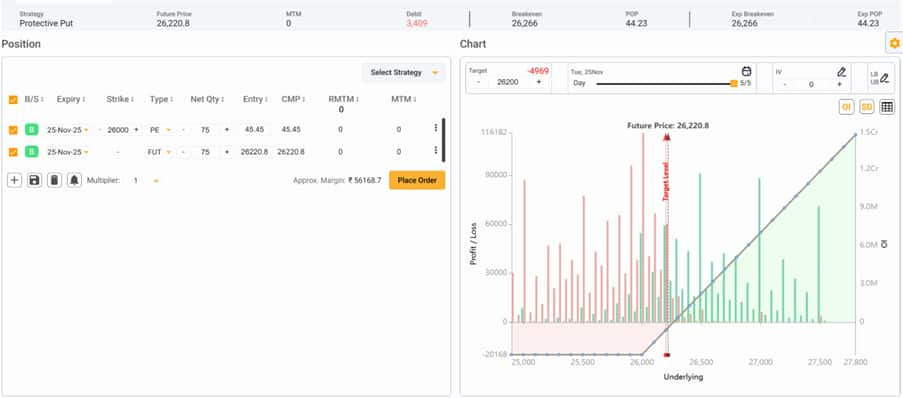Open Interest: An additional tool for traders to decode market expectations
Open Interest or OI is the total number of open contracts in an instrument outstanding in the market at a given point in time. These contracts are generated by transactions between buyers of instrument and sellers of them.
SHUBHAM AGARWAL | 04-Mar-18
Reading Time: 3 minutes

Decoding the market expectations is one of the key steps a trader takes before placing his bets. Unless there exists a different forecast than the market; a trade does not exist as the price will account for those expectations.
However, one of the outputs to note is the key levels where a major change could be expected. Derivative Analysis provides an important tool to the kitty of a trader known as ‘oi’.
What is Open Interest?
Open Interest or OI is the total number of open contracts in an instrument outstanding in the market at a given point in time. These contracts are generated by transactions between buyers of instruments and sellers of them.
A buy and sell trade together forms a contract and with more unique transactions, more contracts are opened. Open interest (OI) can be found in both Futures as well as
Options contracts
. In this article, we’ll understand about Option contracts.
How should one read Options Open Interest?
Options open interest is generally seen ‘Strike’ wise where unique instruments (separated for different expiries, calls, and puts) are plotted in a table or chart format.
The highest Call Open Interest is assumed to be the level of resistance and the highest Put Open Interest is seen as the level of support.
Options Writers are expected to be the smart money and they tend to have a fair understanding of the market if they expect the market to respect a resistance they would trade to sell that strike which is decoded to be a level of resistance and vice versa for a support with put strikes.
##Quick Tips to trade options using Options Open Interest Data efficiently:##
Underlying quoting near highest Call Open Interest after a Bull Run:
If the underlying instrument tends to trade around the highest (or relatively high) level of Call Open Interest and with a rule that any material Open Interest doesn’t reduce, that can be generally taken as an indication of a stiff level of resistance and the underlying instrument can correct from those levels.
Underlying quoting near highest Put Open Interest after a Correction:
If the underlying instrument is quoting near the highest (or relatively high) level of Put Open Interest and any material Open Interest doesn’t reduce, it can be an indication of a strong support and hence, the instrument can witness pullback/reversal from those levels.
##Very Highly congested Open Interest in multiple strikes of Calls & Puts spread across Strikes:##
This could be an indication of the underlying expected to be in an oscillating zone with no directional movement. In such situations, deploying an Oscillating strategy like Butterfly, Short Straddle, Short Strangle, etc. could be beneficial.
Writing in ATM Call or Put Options:
If a writing is witnessed in At the Money Calls or Puts, that’s an indication of an aggressive trade and the expectation could be an immediate fall in case of a Call writing or immediate rise in the case of Put Writing.
Learn and read more about NSE India from Quantsapp classroom which has been curated for understanding of options and open interest from scratch, to enable option traders grasp the concepts practically and apply them in a data-driven trading approach.
Recent Articles

Best trending option trading strategies: Shubham Agarwal
29-Nov-25

3 best ways to hedge using Options: Shubham Agarwal!
22-Nov-25

When in doubt to write, do Iron Fly: Shubham Agarwal!
15-Nov-25

Identify potential turning points with advance-decline: Shubham Agarwal
08-Nov-25

Slow and spreads more efficient: Shubham Agarwal
01-Nov-25

Use implied volatility as probable top finder: Shubham Agarwal
25-Oct-25

How to trade potential breakout post consolidation: Shubham Agarwal!
18-Oct-25

Use Options OI for intraday trading: Shubham Agarwal
11-Oct-25

SHUBHAM AGARWAL is a CEO & Head of Research at Quantsapp Pvt. Ltd. He has been into many major kinds of market research and has been a programmer himself in Tens of programming languages. Earlier to the current position, Shubham has served for Motilal Oswal as Head of Quantitative, Technical & Derivatives Research and as a Technical Analyst at JM Financial.
Recent Articles

Best trending option trading strategies: Shubham Agarwal
29-Nov-25 09:32:00

3 best ways to hedge using Options: Shubham Agarwal!
22-Nov-25 09:11:00

When in doubt to write, do Iron Fly: Shubham Agarwal!
15-Nov-25 10:48:00

Identify potential turning points with advance-decline: Shubham Agarwal
08-Nov-25 10:35:00

Slow and spreads more efficient: Shubham Agarwal
01-Nov-25 10:35:00

Use implied volatility as probable top finder: Shubham Agarwal
25-Oct-25 09:56:00

How to trade potential breakout post consolidation: Shubham Agarwal!
18-Oct-25 09:20:00











